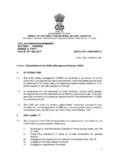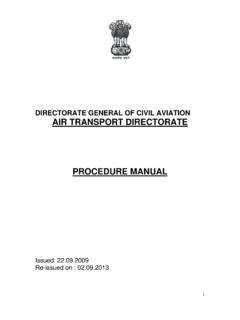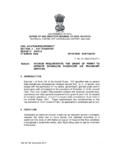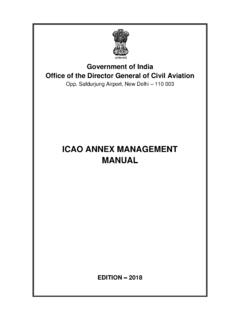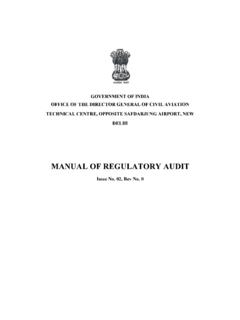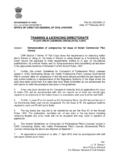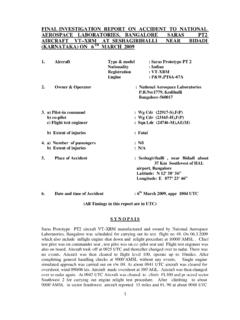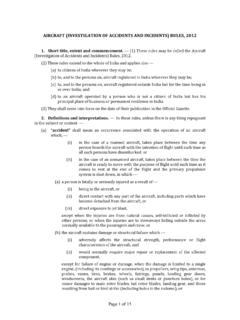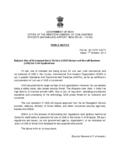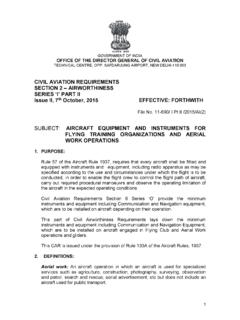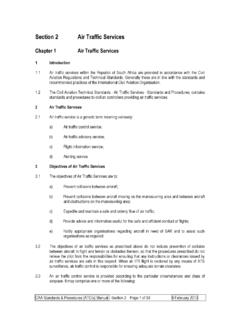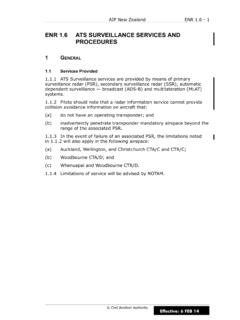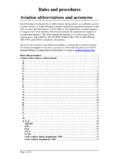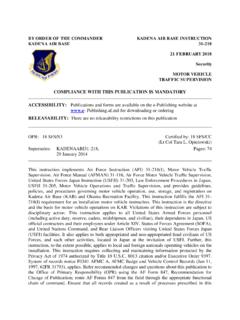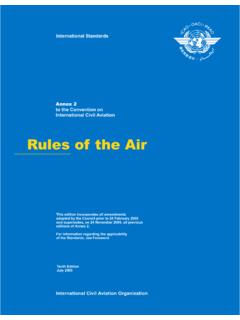Transcription of CIVIL AVIATION REQUIREMENTS SECTION 4 - …
1 1 GOVERNMENT OF INDIA OFFICE OF DIRECTOR GENERAL OF CIVIL AVIATION TECHNICAL CENTRE, OPP SAFDARJANG AIRPORT, NEW DELHI CIVIL AVIATION REQUIREMENTS SECTION 4 - AERODROME STANDARDS & AIR TRAFFIC SERVICES SERIES 'B', PART II 21st December, 2005 EFFECTIVE: FORTHWITH Subject: Minimum Safety REQUIREMENTS for temporary Helicopter Landing Areas. 1. INTRODUCTION Rule 78 of the Aircraft Rules, 1937 requires licensing of such aerodromes that are used as regular place of landing and departure by a scheduled air transport service or for a series of landings and departures by any aircraft carrying passengers or cargo for hire or reward.
2 Further, sub rule (4) of the said rule stipulates that no person shall operate or cause to be operated any flight from a temporary aerodrome or an aerodrome which has not been licensed or approved, as the case may be, under these rules unless it meets the minimum safety REQUIREMENTS laid down by the Director-General. Helicopters are, by design, able to use non-conventional operating sites. Helicopters offer significant advantage over the use of aeroplanes for passenger transport by being able to operate away from conventional aerodromes into and from ad hoc sites or specially designed heliports.
3 Heliport or helicopter sites are not required to be licensed unless they are to be used by a schedule transport service and/ or for public transportation involving series of landing and/ or hire and reward. In pursuance to sub rule (4) of Rule 78 this part of the CIVIL AVIATION REQUIREMENTS lays down the minimum safety REQUIREMENTS for helicopters operating to/from temporary helicopter landing areas within the Indian Territory outside an aerodrome. This CAR is issued under the provisions of Rule 133A of the Aircraft Rules, AVIATION REQUIREMENTS SECTION 4 SERIES 'B', PART II 21ST DECEMBER 2005 22.
4 Applicability This CAR provides the minimum safety requirement considered necessary for helicopter landing areas located outside an aerodrome, for temporary use by helicopters engaged on chartered/ private flight operation. The term temporary used here means a place not used by the same helicopter operator for landing and take off for more than 7 days within a consecutive period of 30 days. These REQUIREMENTS do not apply to elevated heliports, on top of buildings, constructions, etc. 3. General Safety REQUIREMENTS This CAR does not absolve the helicopter operator from compliance of any other requirement that are laid down in relevant CARs for the operation and maintenance of the helicopter.
5 The site to be used for temporary helicopter operations should be a level piece of well-drained ground, either good grass or solid surface free from loose stones, debris. The Final Approach and Take off Area should be obstruction free. Before undertaking any such flight, the helicopter operator and/ or his pilot must satisfy himself by his physical inspection on ground/ air and/ or obtaining required information from District authorities that surroundings are free from obstacles and the site suitable for operations of type of helicopter being operated and there is sufficient open space to force land, if necessary.
6 If the temporary helicopter landing area is situated within aerodrome traffic zone or aerodrome control zone of a public aerodrome, the flight shall be coordinated with the air traffic control at the aerodrome concerned. Pilots operating to these sites must comply with the aerodrome procedures when operating within the Aerodrome Control Zone. The details of the site like name of site, and grid reference shall be given to the air traffic services of that aerodrome. Helicopter operator through their Accountable Manager shall be responsible for the safety of helicopter operations, passengers and people on ground.
7 Permission of owner of the site shall be obtained, before it is used for helicopter operation and the district authorities notified in advance. It is the responsibility of the owner or the person having control of such place to ensure that the land is used as per the applicable local regulations. When such place is used by helicopters carrying VIP all instructions issued from time to time in this regard shall be complied with by the operator through his Accountable Manager/ Pilot CIVIL AVIATION REQUIREMENTS SECTION 4 SERIES 'B', PART II 21ST DECEMBER 2005 At least one 12 kg powder (DCP) fire extinguisher shall be available at the landing/ take-off area, clearly marked and situated so that it can be used quickly in case of fire.
8 A first aid box shall be placed within easy reach and clearly marked. The box shall be maintained in accordance with the instructions and its contents shall be supplemented whenever used. While manoeuvring the helicopter in a low hover, helicopter should be manoeuvred in such a manner that its centreline is not closer to any objects/building than x Rotor Diameter or 30 metres, whichever is the greater. Approach and departure shall be performed within sectors which as far as possible shall be in direct continuation of the take-off and landing directions, respectively.
9 The sectors shall be without obstacles in the entire width and in a vertical distance of at least 35 ft from the approach and departure surfaces. Approach and departure shall be performed in a way that forced landing can be carried out on a suitable emergency landing area at any time, unless a helicopter with one engine out of operation is capable of clearing any obstacle in the sector with a clearance of at least 35 ft. Prior Operational authorization would be required from the DGCA, in case Air Taxi and/ or sightseeing flights are undertaken from such a place. 4. Site REQUIREMENTS Touch down and Lift off area (TLOF) The minimum dimensions of the TLOF shall be 2 B X 2 B, where B equals the wheel base or the side base of the helicopter whichever is more, of the helicopter used (Ref Annexure I).
10 A TLOF shall be capable of supporting the weight of the helicopter intended to be used. Final Approach and Take-off area (FATO) TLOF shall be encompassed by a FATO. The minimum dimensions of the FATO shall be A x A, where A equals the maximum overall length of the helicopter used (Ref Annexure I). This area shall be without obstructions. The surface shall be suitable for forced landings and free from loose objects, which may endanger the safe performance of the flight. Marking A helicopter identification marking shall be provided within the TLOF area and shall consist of letter H white in colour.
